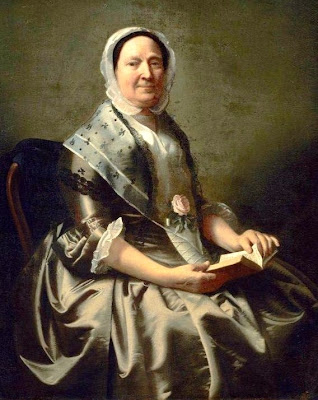 1763 Sarah Tyler (Mrs. Samuel Phillips Savage)
1763 Sarah Tyler (Mrs. Samuel Phillips Savage) 1764 Miriam Kilby (Mrs. Samuel Hill)Whether painting fancy matrons wearing the latest fashions or plainly dressed, more formal religious women, many of John Singleton Copley's paintings of older New England women seem more direct, thoughtful, & stronger than his portraits of younger women.
1764 Miriam Kilby (Mrs. Samuel Hill)Whether painting fancy matrons wearing the latest fashions or plainly dressed, more formal religious women, many of John Singleton Copley's paintings of older New England women seem more direct, thoughtful, & stronger than his portraits of younger women. 1764 Mrs. Anna Dummer Powell.Copley lets us know that these are the surviving matriarchs who deserve the best upholstered chair in the candlelit parlor. Old age offers the leisure & independence to read & to reflect.
1764 Mrs. Anna Dummer Powell.Copley lets us know that these are the surviving matriarchs who deserve the best upholstered chair in the candlelit parlor. Old age offers the leisure & independence to read & to reflect.+Harvard+Univ+1st-gallery-art.com.jpg) 1766 Sarah Morecock (Mrs. Thomas Boylston).Many are holding books, actively involved in the life of the mind & the world beyond Boston. Copley & his sitters decided to show that continuing to seek knowledge was important in 18th century New England whether for devotion, entertainment, or instruction.
1766 Sarah Morecock (Mrs. Thomas Boylston).Many are holding books, actively involved in the life of the mind & the world beyond Boston. Copley & his sitters decided to show that continuing to seek knowledge was important in 18th century New England whether for devotion, entertainment, or instruction. 1766 Mrs-Sylvanus-Bourne.
1766 Mrs-Sylvanus-Bourne..jpg) 1766 Ann Sargent (Mrs. Nathaniel Ellery).
1766 Ann Sargent (Mrs. Nathaniel Ellery). 1767-69 Mary Edwards (Mrs Ebenezer Storer).
1767-69 Mary Edwards (Mrs Ebenezer Storer). 1767 Hannah White (Mrs Robert Hooper).
1767 Hannah White (Mrs Robert Hooper). 1769 Mrs. Isaac Royall.
1769 Mrs. Isaac Royall. 1770 Katherine Graves (Mrs James Russell).
1770 Katherine Graves (Mrs James Russell). 1770 Relief Dowse (Mrs Michael Gill).
1770 Relief Dowse (Mrs Michael Gill).+Nat+Gal+Art,+Wellington,++New+Zealand1st-gallery-art.com.jpg) 1771 Mary Charnock (Mrs. Humphrey Devereux, Mrs. Samuel Greenwood, Mrs. Joseph Prince)
1771 Mary Charnock (Mrs. Humphrey Devereux, Mrs. Samuel Greenwood, Mrs. Joseph Prince)+MFA+Houston1st-gallery-art.com.jpg) 1771 Mrs. Paul Richard (Elizabeth Garland)
1771 Mrs. Paul Richard (Elizabeth Garland) 1771 Elizabeth Lewis (Mrs Ezekiel Goldthwait).
1771 Elizabeth Lewis (Mrs Ezekiel Goldthwait). 1773 Hannah Fayerweather (Mrs John Winthrop)..
1773 Hannah Fayerweather (Mrs John Winthrop)..







+1st-gallery-art.com.jpg)


+San+Fran+Fine+Arts+1st-gallery-art.com.jpg)


+Minneapolis+Inst+of+Arts1st-gallery-art.com.jpg)


+Art+Inst+of+Chicago+1st+gal.jpg)


.+Portrait+of+a+Woman.+(Reproduction+at+1st-art-gallery.com.).jpg)
.+Lucretia+Hubbard+Towsend.+(Reproduction+at+1st-art-gallery.com.).jpg)
.+Hannah+Hill+(Mrs.+Samuel+Quincy).+Museum+of+Fine+Arts,+Boston.+(Reproduction+at+1st-art-gallery.com..jpg)
.+Catherine+Osborne+(Mrs.+Epes+Sargent).+(Reproduction+at+1st-art-gallery.com.).jpg)
.+Elizabeth+Deering+Wentworth+Gould+(Mrs.+Nathaniel+Rogers).+High+Museum+of+Art,+Atlanta,+Georgia.+(Reproduction+at+1st-art-gallery.com..jpg)
.+Katherine+Russell+(Mrs.+Samuel+Henley).+Museum+of+Fine+Arts,+Boston..jpg)
.+Mary+Storer+(Mrs+Edward+Green)..jpg)
.+Mrs.+Joseph+Scott.+Newark+Museum,+New+Jersey..jpg)
.+Elizabeth+Green+(Mrs.+Ebenezer+Storer+II)..jpg)
.+Mrs.+George+Turner.+(Reproduction+at+encore-editions.com.).jpg)
.+Ann+Holmes+(Mrs.+William+Coffin).+Museum+of+Fine+Arts,+Boston..jpg)
.+Elizabeth+Goldthwait+(Mrs.+Alexander+Cumming).+Brooklyn+Museum.+(Reproduction+at+1st-art-gallery.com..jpg)
.+Susanna+Clarke+(Mrs.+John+Singleton+Copley).+Henry+Francis+duPont+Winterthur+Museum..jpg)
.+Dorothy+Quincy+(Mrs.+John+Hancock).+Museum+of+Fine+Arts,+Boston.+(Reproduction+at+1st-art-gallery.com..jpg)
.+Dorothy+Wendell+(Mrs.+Richard+Skinner).+Museum+of+Fine+Arts,+Boston.+(Reproduction+at+1st-art-gallery.com..jpg)
+Ezekiel+Hersey+Derby+Farm.jpg)
+Harbor+View.jpg)
+New+England+Country+Seat.jpg)
.+Rebecca+Orne+(later+Mrs.+Joseph+Cabot).+Worcester+Museum+of++Art..jpg)
